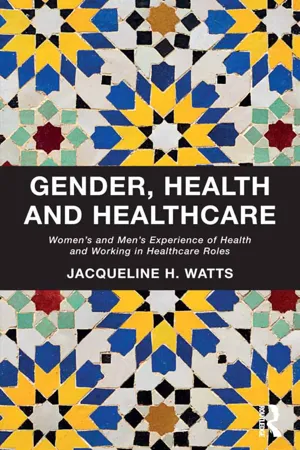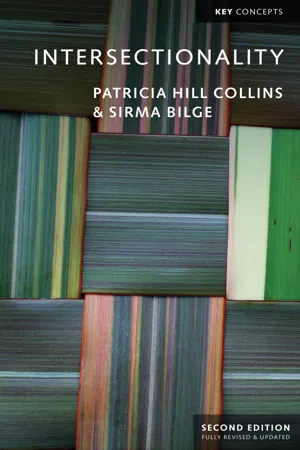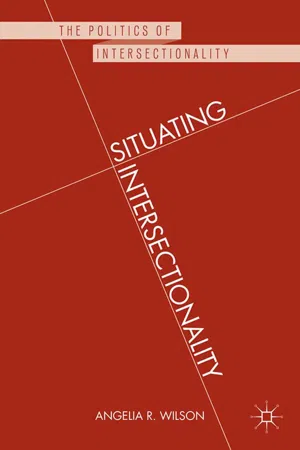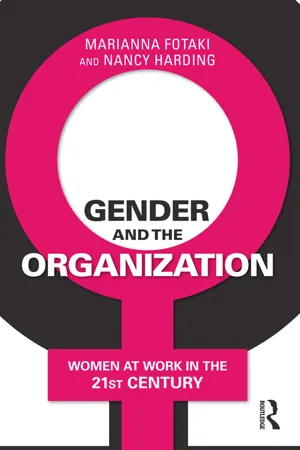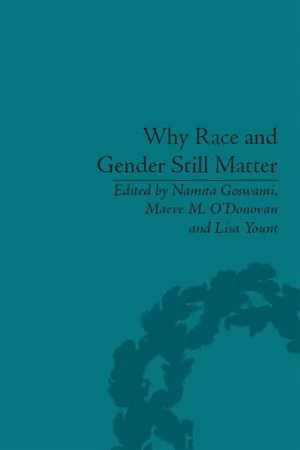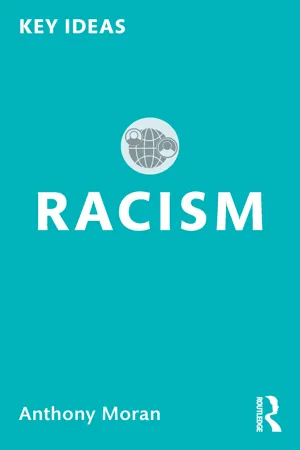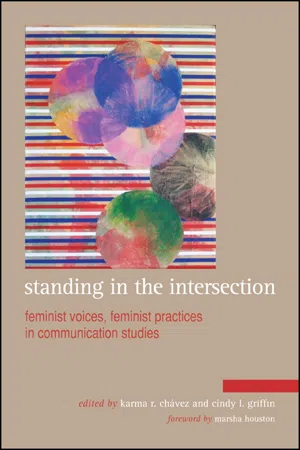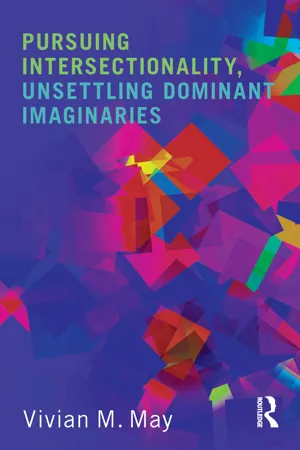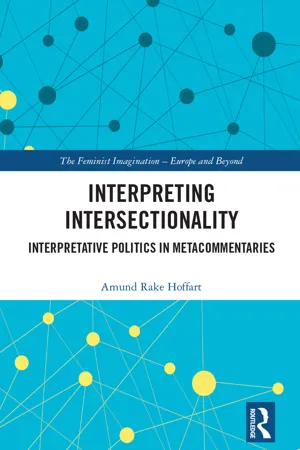Literature
Intersectionality
Intersectionality is a concept that acknowledges the interconnected nature of social categorizations such as race, gender, class, and sexuality, and how they intersect to create unique experiences of discrimination and privilege. In literature, intersectionality is used to analyze how multiple forms of oppression and identity interact within characters and narratives, providing a more nuanced understanding of social dynamics and power structures.
Written by Perlego with AI-assistance
Related key terms
Related key terms
1 of 4
Related key terms
1 of 3
11 Key excerpts on "Intersectionality"
- eBook - ePub
Feminist Theory Reader
Local and Global Perspectives
- Carole McCann, Seung-kyung Kim, Emek Ergun, Carole R. McCann, Seung-kyung Kim, Emek Ergun(Authors)
- 2020(Publication Date)
- Routledge(Publisher)
One point of general agreement among intersectional scholars is that the experiences and texts of traditionally marginalized groups were not considered knowledge thirty years ago. Yet the writings, ideas, experiences, and perspectives of people whose lives were once considered unimportant are increasingly influencing traditional disciplines. In the field of sociology, for example, intersectional analysis has extended and combined traditional subareas of stratification, race and ethnicity, and family by drawing on conflict theory, theories of racialization (Massey & Denton, 1993; Omi & Winant, 1994; Oliver & Shapiro, 1995) and gender stratification (Lorber, 1994, 1998; Myers et al., 1998; Kimmel, 2000; Gardiner, 2002). These subareas, combined with ideas drawn from ethnic studies, critical legal theory, and postmodernism, explore the ways identity flows from and is entangled in those relationships and how systems of inequality (race, ethnicity, class, gender, physical ability, and sexuality) are embedded in and shape one another. Intersectionality is both a reflection of and influence upon some of the newer directions in fields such as history, sociology, legal studies, and anthropology to name a few. It does this by examining relationships and interactions between multiple axes of identity and multiple dimensions of social organization—at the same time.… [W]e treat Intersectionality as an analytical strategy—a systematic approach to understanding human life and behavior that is rooted in the experiences and struggles of marginalized people. The premises and assumptions that underlie this approach are: inequalities derived from race, ethnicity, class, gender, and their intersections place specific groups of the population in a privileged position with respect to other groups and offer individuals unearned benefits based solely on group membership; historical and systemic patterns of disinvestment in nonprivileged groups are major contributors to the low social and economic position of those groups; representations of groups and individuals in media, art, music, and other cultural forms create and sustain ideologies of group and individual inferiority/superiority and support the use of these factors to explain both individual and group behavior; and individual identity exists within and draws from a web of socially defined statuses, some of which may be more salient than others in specific situations or at specific historical moments.As Weber (2001) points out, intersectional analysis operates on two levels: at the individual level, it reveals the way the intermeshing of these systems creates a broad range of opportunities for the expression and performance of individual identities. At the societal/structural level, it reveals the ways systems of power are implicated in the development, organization, and maintenance of inequalities and social injustice. In both writing and teaching, scholars engaged in this work are challenged to think in complex and nuanced ways about identity and to look at both the points of cohesion and fracture within groups (Weber, 2001; Dill & Johnson, 2002) as they seek to capture and convey dynamic social processes in which individual identities and group formations grow and shift in continuous interaction with one another, within specific historical periods and geographic locations. - eBook - ePub
Gender, Health and Healthcare
Women's and Men's Experience of Health and Working in Healthcare Roles
- Jacqueline H. Watts(Author)
- 2016(Publication Date)
- Routledge(Publisher)
Chapter 9Intersectionality
Introduction
Relations of oppression and structural disadvantage, long the focus of feminist activism, are experienced in the micro-environments in which individuals live out their lives, but these are set within the broader social macro-environment shaped by the politics of all kinds of social difference that inform our identity. The concept of Intersectionality recognises that individual identity is multi-faceted and made up of diverse characteristics of ‘selfhood’, with our gender as only one dimension of who we are and how others see us. Race, class and sexual orientation, as well as gender, are simultaneous processes of identity that operate as institutional and social practice. Intersectionality emphasises that these social categories are inextricably entwined and, as argued by Penner and Saperstein (2013), interrogation of the co-constitution of these axes of stratification has proven difficult to implement within both quantitative and qualitative analyses.Feminism has been absorbed with theorising difference both between women and men and also, more latterly, between women. As a result, much important work has been done on specific oppressions associated with class, race and sexuality that in its production, has uncovered the critical problems of authenticity and standpoint. This is captured by posing the question ‘whose voice is represented here’, articulated in Stacey’s (1997: 62) claim that: “it is the exclusive prerogative of those who have experienced an oppression or a lifestyle to define its politics”. The feminist concept of ‘standpoint theory’ has thus emerged to be taken up by many in the academy as a way of bringing authentic rigour to their scholarship as well as contributing to epistemologies of the oppressed (see Stanley and Wise, 1993). The adoption of standpoint theory within feminist writing has also been a mechanism for ‘celebrating difference’ such that attributes, formerly stigmatised, were reclaimed, owned and valued (see, as an example, the work of Skeggs, 1997, for a critique of the intersection of class and gender). Increasingly we are seeing feminist goals engaging with intersecting projects that are aimed at reducing social inequality of all kinds, with this as evidence of Walby’s (2011: 151) claim that “feminism rarely acts alone”. - eBook - ePub
- Patricia Hill Collins, Sirma Bilge(Authors)
- 2020(Publication Date)
- Polity(Publisher)
Maintaining this creative tension between critical inquiry and critical praxis remains an ongoing challenge for Intersectionality. Yet many people within academia, within activist settings, as well as within digital Intersectionality do not see this relationship between inquiry and praxis as foundational to Intersectionality’s critical work. Some scholars wish to extract Intersectionality from praxis, leaving a purified set of ideas that can be manipulated unencumbered by the kinds of political stakes that have concerned intersectional practitioners. Similarly, activists who interpret Intersectionality as being overly abstract and not worth studying demonstrate an anti-intellectual bias that elevates praxis over serious study. As the debates within online feminist publics and the spread of digital violence suggest, Intersectionality’s footprint within digital media can make conflict more overt and amplified. Significantly, creativity honed by placing inquiry and praxis in dialog need not generate consensus – indeed, it often catalyzes conflict. Yet being critical requires dialogs across differences in power, as long as such dialogs are committed to strengthening Intersectionality.The term “Intersectionality” is very much in use these days, but is employed in a variety of ways by different social actors. We see the impetus toward Intersectionality as more connected to the puzzles presented by the social world that we live in, rather than the concerns of established disciplinary endeavors. Our efforts to provide a useful but not final definition of Intersectionality speak to the impetus to encompass Intersectionality’s dual focus on inquiry and praxis. Toward this end, we began this book by offering the following description of Intersectionality:Intersectionality investigates how intersecting power relations influence social relations across diverse societies as well as individual experiences in everyday life. As an analytic tool, Intersectionality views categories of race, class, gender, sexuality, class, nation, ability, ethnicity, and age – among others – as interrelated and mutually shaping one another. Intersectionality is a way of understanding and explaining complexity in the world, in people, and in human experiences.We settled on this working definition because it is broad and elastic enough to house the diversity within Intersectionality, yet provides some guidance on some important boundaries around Intersectionality. Throughout the book, we have aimed to deepen this working definition in ways that embrace Intersectionality’s heterogeneity and dynamism.The significance of this working definition goes beyond its organizational utility for this book. The definitional question is important because prematurely settling on one definition, history, or canon can shut down Intersectionality’s creativity and growth. We have tried to avoid these pitfalls by providing a more expansive view of Intersectionality than can be found in any one location. We emphasize how using Intersectionality as an analytic tool introduces greater complexity into a host of topics, such as digitally mediated social movements, climate change, and reproductive justice. Consensus often ends when we dig deeper into Intersectionality’s actual use. We have highlighted some of the debates within Intersectionality, for example, conflicting views of the meaning of identity within Intersectionality. We also discuss the challenges that Intersectionality confronts in remaining critical within varying venues that increasingly adopt neoliberal frameworks, for example, its own placement within the normative standards of higher education and the changing meaning of diversity work within public schools and academia. We avoid some of the most contentious debates that, in our assessment, sweep up Intersectionality in service to other agendas, for example, arguments that “we,” whoever that might be, should move “beyond” Intersectionality to some sort of “post-Intersectionality” landscape. - eBook - ePub
Situating Intersectionality
Politics, Policy, and Power
- Angelia R. Wilson(Author)
- 2013(Publication Date)
- Palgrave Macmillan(Publisher)
1INTERSECTIONALITY FROM THEORETICAL FRAMEWORK TO POLICY INTERVENTIONWendy G. SmoothIntersectionality, the assertion that social identity categories such as race, gender, class, sexuality, and ability are interconnected and operate simultaneously to produce experiences of both privilege and marginalization, has transformed old conversations while inspiring new debates across the academy. Intersectionality encourages recognition of the differences that exist among groups, moving dialogue beyond considering only the differences between groups. Originating from discontent with treatments of “women” as a homogenous group, Intersectionality has evolved into a theoretical research paradigm that seeks to understand the interaction of various social identities and how these interactions define societal power hierarchies. Intersectionality encourages us to embrace the complexities of group-based politics by critically examining the variances in social location that exist among those claiming membership in groups.1At the same time that Intersectionality helps to make sense of the experiences of people who find themselves living at the intersections of social identities, Intersectionality also is concerned with the systems that give meaning to the categories of race, gender, class, sexual identity, among others. In other words, at the societal level Intersectionality seeks to make visible the systems of oppression that maintain power hierarchies and organize society while also providing a means to theorize experience at the individual level.Intersectionality scholarship has emerged as one of the most significant areas of research across academic disciplines. It has been considered “the most important theoretical contribution that women’s studies in conjunction with related fields has made so far” (McCall, 2005, 1771). It has opened a plethora of new and exciting research questions and analyses. Viewing the world from the intersections of various social locations, including race, gender, class, ability, nationality, sexuality, among other locations, has produced an important paradigm shift in terms of how we study and approach questions of hierarchy, inequality, power, and what constitutes the just society. As Berger and Guidroz (2010, 7) argue, Intersectionality represents a new “social literacy” that challenges traditional framing of research questions and methodology. Speaking to the reach of this new social literacy, they assert that to be “an informed social theorist or methodologist in many fields of scholarly inquiry, but most especially in women’s studies, one must grapple with the implications of Intersectionality.” (Ibid.) - eBook - ePub
Gender and the Organization
Women at Work in the 21st Century
- Marianna Fotaki, Nancy Harding(Authors)
- 2017(Publication Date)
- Routledge(Publisher)
In short, her concept of Intersectionality aimed to highlight how different ‘axes’ of identity could lead to multiple ways in which discrimination was experienced by black women: as women, as black, as women and black, and as black women. It was therefore, she argued, insufficient to consider anti-discrimination policies within ‘a single axis framework’ as they did not provide sufficient (or adequate) protection to various categories experiencing multiple threats and disadvantages under the existing legislative framework. Other legal scholars argued similarly that: ‘neither gender nor racial identity groupings alone can describe common experiences, standpoints, and relationships with others’ (Minow, 1996:655–656). While rejecting analytical categories such as race, gender, ethnicity or class as separate and essentialist, they proposed the idea of interconnections and interdependence of race with other categories of which, at the time, class was probably the most important one. It provided a new perspective on previous debates about the intersection of gender and class (e.g. Crompton and Mann, 1986). Various other metaphors other than Crenshaw’s (1989) road traffic intersections were also deployed by other feminist researchers including roundabouts (Garry, 2011), axes (Yuval-Davies, 2006) or curdled eggs to denote the inseparability of oppressions (Lugones, 2007). The importance of understanding the complexities of intra-categorical subject positions is now acknowledged (McCall, 2005).Intersectionality is now a central idea and a category of analysis in feminist and gender studies (Brah and Phillips, 2004; Yuval-Davies, 2006; Valentine, 2007) and earlier presumptions of the homogeneity of women’s experiences are now regarded as naïve and politically dangerous. It is known that the multiple disadvantages experienced by those positioned at the intersections of various markers of difference - eBook - ePub
Intersectionality in Social Work
Activism and Practice in Context
- Suryia Nayak, Rachel Robbins, Suryia Nayak, Rachel Robbins(Authors)
- 2018(Publication Date)
- Routledge(Publisher)
Mirroring the lived experience of ‘difference’, it has been argued that the concept of Intersectionality ‘allows endless constellations of intersecting lines of difference to be explored’ (Davis, 2009: 77). Lewis also asserts that the popularity of Intersectionality demonstrates that knowledge produced by Black women at the margins can go beyond this and form ‘part of a more generalizable theoretical, methodological and conceptual toolkit’ (2013: 871). Cho et al. (2013) underline the importance of Intersectionality as an analytic tool to examine structural-racialised power structures, rather than diverse identities. It is also our view that ‘identity’ must be located in the unequal social structures and dynamics that construct identity in the first place, because ‘Intersectionality primarily concerns the way things work rather than who people are’ (Cho et al., 2013: 923).Given the plurality of ways in which the concept is used, McCall (2005) argues that intersectional theories comprise an ‘epistemological continuum’, namely: inter categorical approaches that emphasise discrete social categories of race, class and gender, produced by structural inequalities that construct individual identities. Here, the intersectional project highlights inequality between social groups; intracategorical approaches interrogate the essentialised nature of discrete social categories, whilst recognising the utility of strategic essentialism (for instance, emphasising the unique experiences of violence for Black women located at the intersection of multiple oppressions, to deconstruct the social category of gender); anticategorical (poststructuralist) approaches challenge the idea of fixed and inevitable social categories altogether, seeing them as constructed by language and discourse.The importance of considering the intersection of systems of power and discrimination that shape the experiences of violence among BME women, rather than merely describing experiential diversity, is increasingly emphasised by some (Siddiqui, 2014; Thiara and Gill, 2010). This reinforces the need to consider diverse cultural contexts whilst centring intersectional discrimination based on race, gender, nation, immigration and sexuality. As noted by Lewis (2013), race, and indeed Black women, are being displaced from feminist discussions of Intersectionality in Europe, even though race remains central to political and policy discourses. Concurrently, the displacement of race by culture, religion and ethnicity as the marker of essentialised difference situates the problem with ‘othered’ groups/communities/women themselves. This is reflected in discourses on violence against BME women and girls in the UK where harmful practices are seen to result from ‘othered’ cultures and religions (Chantler and Thiara, 2017). We argue that race and racialised power must be central to intersectional analyses. The focus on subjectivity and identity within Intersectionality studies should not displace the emphasis on racialised structural inequality. - eBook - ePub
Why Race and Gender Still Matter
An Intersectional Approach
- Maeve M O'Donovan, Namita Goswami, Lisa Yount(Authors)
- 2015(Publication Date)
- Routledge(Publisher)
discrimination based on either race or gender, but not race and gender) to demonstrate a need for realizing multiple relationships across seemingly disparate situations. 8 As Anna Carastathis explains, Crenshaw demonstrates the need for an intersectional approach because ‘the conceptual structure of categories of discrimination [e.g. race or gender] is such that when they intersect, they render experiences of compound, simultaneous discriminations invisible’. 9 Intersectionality’s call to look for multiple ways oppression, as a social phenomenon, manifests in complex interactions in our social worlds is borne out of the reality that without such attempts, large swaths of oppression within our social landscapes will be theoretically erased. That is to say, particular ways of conceiving of oppression, e.g. as gendered or raced, serve to create incomplete understandings of the ranges of ways oppression is experienced within our social worlds. As a conceptual tool aimed at better practices of knowledge production concerning oppression, Intersectionality includes certain orientations. Following Vivian May, ‘Intersectionality entails thinking about social reality as multidimensional, lived identities as intertwined, and systems of oppression as meshed and mutually constitutive’. 10 Intersectionality, as a mechanism for the constitution of social facts about oppression, calls for methodological orientations that include, but are not limited to, the consideration that our social landscapes are exceedingly complex and particular locations within these landscapes can be very difficult to identify depending on one’s pre-existing socio-epistemic orientation. Namely, most, if not all, socio-epistemic orientations towards oppression will illuminate as much as they obscure. One of the ways to counter this reality is to seek out connections where one might ordinarily not look - Anthias and Yuval-Davis (1993 , p. 2) argue, Intersectionality leads to a different understanding of the nature of racisms, and the differential ways that they are experienced, and calls for an alertness to the multiplicity of factors that affect exclusion:In our view, the explication of racisms therefore cannot be undertaken purely with reference to ethnic or race phenomena. An adequate analysis has to consider processes of exclusion and subordination in intersection with those of the other major divisions of class and gender as well as processes of state and nation.This chapter also addresses understandings of racism that emphasise its systemic, structural or institutional nature – as this involves an important reframing of the understanding of racism, and in particular shifts emphasis away from individualistic and psychological views of racism that focus on expressions of prejudice (Song 2014 ).
THE CHALLENGE OF Intersectionality
Prior to Crenshaw’s essay, the main ideas of Intersectionality had been articulated in the famous ‘The Combahee River Collective Statement’ from black feminists, who stated that ‘we are actively committed to struggling against racial, sexual, heterosexual, and class oppression, and see as our particular task the development of integrated analysis and practice based upon the fact that the major systems of oppression are interlocking’ (Combahee River Collective [1977] 2014 , p. 271). Angela Davis (1981) focused on the ways that race, class and gender (‘women’) intersected, arguing, in a discussion of rape, that ‘racism nourishes sexism’ and instigates rape (Davis 1981 , Ch. 11; quote at p. 177). Davis explained how racism shaped not only black women’s experiences of rape, but also the particular forms of black women’s rape protest, including their reluctance to fully embrace white women’s political protest because of the way that black men were stereotyped as the rapists of white women and had been indiscriminately lynched on the false pretext that they had raped white women, as well as prosecuted in numbers far outweighing white male rapist prosecutions. Audre Lorde in her 1980 lecture ‘Age, Race, Class, and Sex: Women Redefining Difference’ (republished in Lorde 1984 - eBook - ePub
Standing in the Intersection
Feminist Voices, Feminist Practices in Communication Studies
- Karma R. Chavez, Cindy L. Griffin, Karma R. Chavez, Cindy L. Griffin(Authors)
- 2012(Publication Date)
- SUNY Press(Publisher)
This introduction will explore the definitions of and metaphors for Intersectionality and what those definitions and metaphors tell us about intersectional scholarship and the difficult work scholars must do. We then provide an overview of key moments in the past fifty years of communication and rhetorical scholarship—moments that represent foundational attempts to attend to race, gender, class, or sexuality—in order to call attention to the ways these first attempts to address identities other than the heterosexual, white, middle-class male, moved our thinking about Intersectionality forward, stalled that thinking, or perhaps offered some of both. Finally, we turn this discussion toward suggesting what intersectional scholarship might look like in the work of scholars interested in studying symbolic exchanges and some of the difficulties inherent to intersectional approaches. With these sections, we hope to stimulate the thinking of those interested in intersectional work in communication and rhetorical studies, and beyond, to tease out the nuances and difficulties of that work and to contribute to the lively and productive conversations that are just now reaching the pages of our scholarship regarding Intersectionality.Intersectionality: CONSIDERATIONS, DEFINITIONS, METAPHORS
During the midst of multiple, interwoven struggles for liberation catalyzed in the middle of the 20th century in the United States, U.S. third world feminists began to theorize the “multiple displacements” that shaped U.S. women of color identities.7 These feminists of color, working-class feminists, and lesbians articulated the “interlocking” nature, as well as the “double” or “multiple jeopardy”8 of having several oppressed identities.9 From writings and speeches such as these, Black10 feminist legal scholar Kimberlé Crenshaw named and derived a theory of Intersectionality. Crenshaw's early work articulated the ways in which the experiences of women of color, poor, and immigrant women are subsumed and erased in legal practices, political decisions, and social norms. This erasure occurs, according to Crenshaw, because in fundamental ways, all women are assumed to be white, and all Blacks are assumed to be men within arenas such as law, politics, and media representation.11 - Vivian M. May(Author)
- 2015(Publication Date)
- Routledge(Publisher)
Using a diverse demographic is not, on its own merits, adequate—and Intersectionality is not only about ‘identity’: what remains unasked (and unanswered) is, how can the goal of “real access to education and training” be attained if racism is left off the table in “intersectional” gender policy (and in research about such policy)? Furthermore, what does it mean to conflate “race” with “poverty” within the category “class”—to use “class” to make race disappear, even as gender and marital status come forward as salient structural and personal factors? While Gatta urges that future programs account for race in more meaningful ways, more needs to be said about how and why race was taken as a “given” and thus was not analyzed as meaningful or impactful, other than as an indictor for poverty—‘race’ here also stands in for non-whiteness, meaning whiteness’ transparency was also taken for granted.Beyond U.S. contexts, Intersectionality is increasingly being used in NGO, state, and supranational contexts to address inequality via policy formation and law reform. For instance, it served as a crucial lens at the 2001 World Conference against Racism (Blackwell and Naber 2002; Falcón 2012; Yuval-Davis 2006). The South African Constitution (1996) also formally recognizes an intersectional approach to rights and redress in its equality clause.12 Supranational organizations, including the United Nations (UN) and the European Union (EU), have begun to understand the need to account for interlocking forms of oppression. The UN thus has a “Special Rapporteur on Violence against Women,” and some have used this position to apply Intersectionality contextually.13 In 2011, Rashida Manjoo issued a report on intersectional discrimination and violence emphasizing indivisibility of oppressions, within-group differences among women, and structural dynamics.14 A decade prior, Radhika Coomaraswamy, in preparation for the World Conference against Racism, employed Intersectionality to challenge the UN’s tendency to compartmentalize forms of discrimination via an either/or race versus gender lens (Coomaraswamy 2001).In the Americas, Intersectionality is also being widely applied. For example, Canadian human rights law references Intersectionality with the aim of recognizing interacting forms of inequality (Aylward 2010; Froc 2010); it is also being used as a policy instrument, particularly to improve national and provincial health policies.15- eBook - ePub
Interpreting Intersectionality
Interpretative Politics in Metacommentaries
- Amund Rake Hoffart(Author)
- 2023(Publication Date)
- Routledge(Publisher)
3 Intersectional IntersectionalityDOI: 10.4324/9781003373476-3Introduction
This chapter, along with the next two, analyses metacommentary attempts to define a field of Intersectionality studies. For any newly established academic field, the process of trying to delimit the field’s core concepts and methods and reach a common understanding of them can be painful and laden with conflict. While attempts to provide answers to questions about Intersectionality’s past, present and future might have a unifying purpose, they can just as easily create division and controversy. I have already referred to the heated feminist contestations over Intersectionality, the so-called Intersectionality wars, a term referring to the fact that[n]early everything about Intersectionality is disputed: its histories and origins, its methodologies, its efficacy, its politics, its relationship to identity and identity politics, its central metaphor, its juridical orientations, its relationship to black woman and to black feminism.(Nash, 2017 , pp. 117–118)The proliferation of morally charged words used in the metacommentary debates over Intersectionality as a project, like epistemic violence (May, 2015 , p. 95), colorblindness (Carbado, 2013 , p. 817), whitening (Bilge, 2013 , p. 412) and colonizing (Tomlinson, 2013a , p. 265), can be read as a testament to the contentious nature of these discursive debates.Framing the processes of drawing borders around one’s academic project as only sparking conflict, however, does not provide us with the whole picture. Hemmings’ work on the dominant narratives within feminist theory of its own historical development contains a key insight which can be summarised in the observation that despite a rhetorical insistence on multiple feminisms, Western feminist trajectories emerge as startlingly singular (2005
Index pages curate the most relevant extracts from our library of academic textbooks. They’ve been created using an in-house natural language model (NLM), each adding context and meaning to key research topics.
Explore more topic indexes
Explore more topic indexes
1 of 6
Explore more topic indexes
1 of 4

